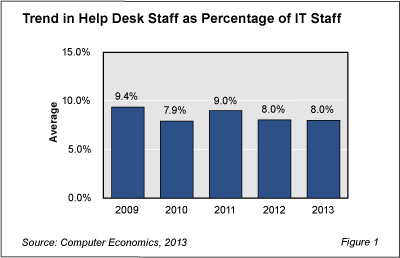Over the past four years, help desk staffing levels have remained relatively constant when viewed as an average percentage of the IT staff.
In Figure 1 from our study, Help Desk Staffing Ratios, we see that the help desk staff across all sizes of organizations ranged on average from a low of 7.9% in 2010 to a high of 9.4% in 2009. In 2013, the ratio is near the low side of the range, at 8.0%, for the composite sample. The ratio will vary by organization size and sector, but these metrics provide an assessment of the overall trend in help desk staffing.

Help desk staffing does appear to have fallen significantly from its 2009 high, but that may reflect layoffs at the beginning of the recession. In part, the annual fluctuation in average help desk staffing reflects relative changes in the staffing mix. Other positions could be growing or shrinking, making the help desk staff appear smaller or larger as a percentage of the total. While staffing mix changes account for some fluctuation during this tumultuous five-year period, we find that help desk staffing remained relatively steady since 2010.
In our study, we define help desk staff as personnel who provide first-contact support to end users, typically by phone, email, or chat. Help desk staff generally resolve 50% to 80% of incidents at Level 1, often on a first-call basis. They may escalate some Level 2 issues to personnel within the help desk organization..
Because the help desk comprises a sizable portion of the IT staff, it can be a target for outsourcing and efficiency gains through improved processes and automation tools. Yet as organizations absorb more applications and technology, including smartphones and other mobile devices, they also can find a need to expand the help desk function. Moreover, enhancing the help desk function can lead to economies of scale in other technical support functions.
As such, help desk staffing levels require ongoing assessment. An overstaffed help desk can be a drain on the IT budget, while an understaffed operation can sap an organization’s productivity and create dissatisfaction among users. Benchmarking against industry standards is an important starting point for determining whether a help desk is appropriately organized for delivering quality service at the lowest possible cost.
This full study provides metrics for benchmarking help desk staffing levels in the current environment. We look at the trend in help desk staffing over a five-year period and provide two benchmarks by organization size: help desk staff as a percentage of the IT staff and users per help desk staff member. Because companies organize the end-user support function in different ways, we also provide benchmarks for a combined help desk and desktop support staff. We conclude with recommendations on optimizing help desk staffing levels.
This Research Byte is a brief overview of our report on this subject, Help Desk Staffing Ratios. The full report is available at no charge for Computer Economics clients, or it may be purchased by non-clients directly from our website (click for pricing).
Do you also need staffing ratios for other IT job functions? Consider this collection of all of our staffing ratio reports, which bundles them all into a single report at a significant discount: IT Staffing Ratios–Special Report Bundle.

